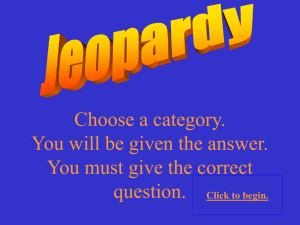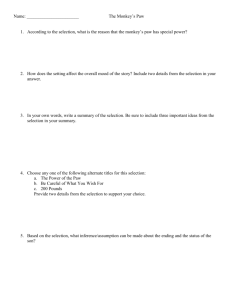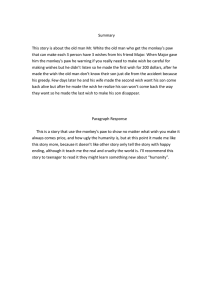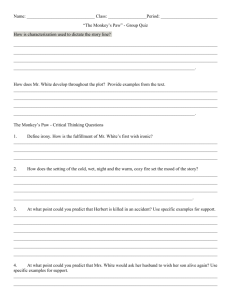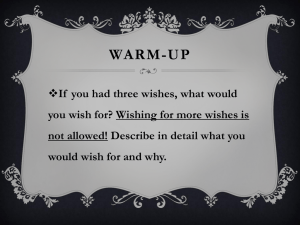Summary Writing
advertisement
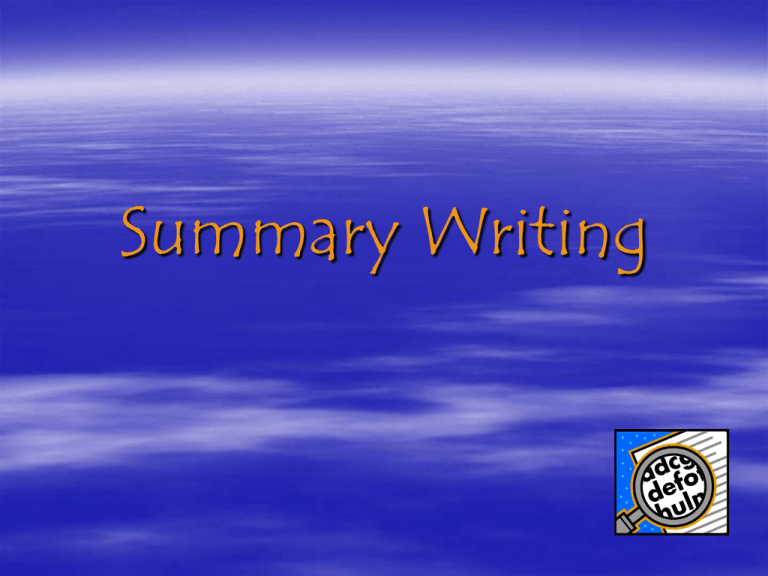
Summary Writing What is a Summary? In a summary the reader… – Pulls out and focuses on central or key ideas – Uses key words or phrases – Puts the text into their own words – Organizes the text into a condensed version – Includes information from beginning, middle and end of the selection What usually happens when you are asked to summarize? Write down EVERYTHING (way too much) Write down next to NOTHING (not enough) Copy word for word Include information from only part of the selection Why Write a Summary? Summaries help the reader … -Score well on the WASL and on class summarizing assignments -Identify and remember the main ideas of a selection – Logically condense information into a shorter version using their own words so they can remember the information Goals for Summary Lessons Learn to write a summary that has a summarizing statement and at least three main events. To learn a strategy for writing summarizing statements To be able to decide if an event is a main event Writing a Summary Statement Start your summary with a summarizing statement What can help you to make a summarizing statement- I + V+ FT= A summarizing statement I= Introduce Answer these questionsWhat is the title? What format is it written in (article, book, poem, etc…) Who is the author? For example, “Tell-Tale Heart”, a short story, by Edgar Allan Poe…. V= Verb Use a verb (action word) Some to considerDescribes Explains Shows Tells Convinces For example“Tell-Tale Heart”, a short story, by Edgar Allan Poe…describes FT= Finishing thought The main thing that happens in the story (the gist). For example, “Tell-Tale Heart”, a short story, by Edgar Allan Poe describes the thoughts, actions and motivations of a crazed but clever man who murdered someone because of his eye and then uncontrollably confessed his crime to the police. Practice with a partner Find someone who read the same story as you (“The Landlady” or “The Monkey’s Paw”) Write a summarizing statement for that story Be sure to include all the parts: – I Introduce author and title – V Verb: describes, tells, persuades etc. – FT Finishing Thought… main ideas from the beginning, middle and end Examples from “The Monkey’s Paw” Summarizing Statement Yes or No? “The Monkey’s Paw”, a short story by W.W. Jacobs, describes the eerie qualities of a magical cursed paw given to the White family. “The Monkey’s Paw”, W.W. Jacobs’s spooky short story, describes a magical cursed monkey’s paw that the White family uses to make wishes with dire consequences. This story describes a creepy paw with magical powers that makes the White family’s wishes come true but in horrible ways. Examples from “The Landlady” Summarizing Statement Yes or No? Roald Dahl creeps his reader out in his short story, “The Landlady” which describes a young man moving to a new town, looking for a place to stay. In Roald Dahl’s short, creepy story, “The Landlady,” he describes how a landlady at a Bed and Breakfast has only had two guests and stuffs her pets and guests. “The Landlady,” a short story by Roald Dahl describes how a landlady cons her naïve guests, in particular Billy Weaver, into staying at her Bed and Breakfast until it is too late for them to escape her manipulative hold.
